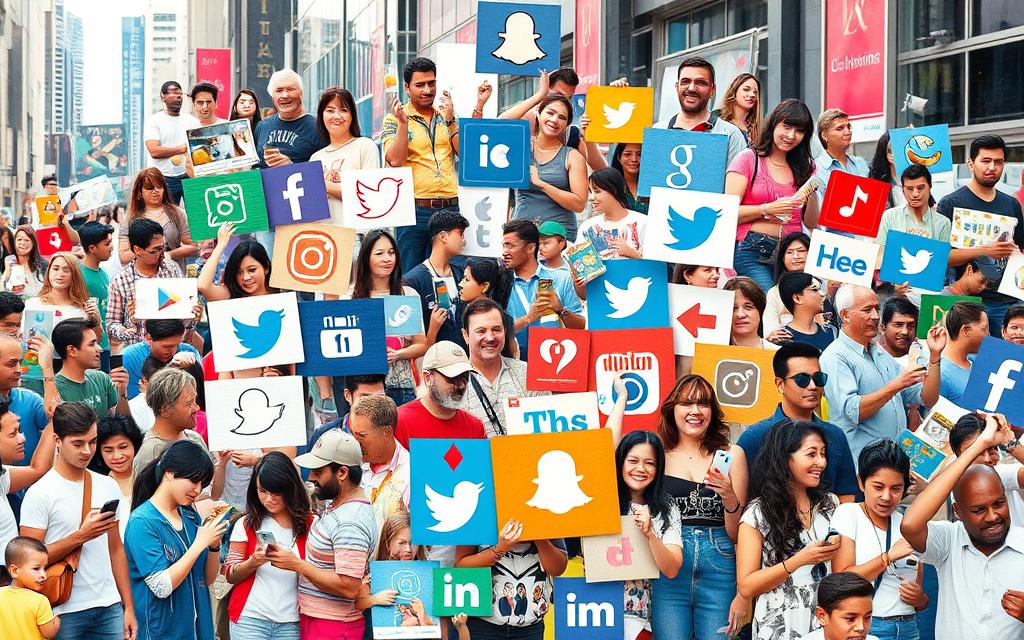Boost Your Brand with User-Generated Content
Did you know 79% of people say user-generated content (UGC) affects their buying choices? Today, UGC is more than just a trend; it’s key for brands wanting to grow and build trust. By using real customer voices, brands can tell stories that connect with people in ways ads can’t.
As people look for real connections with brands, using UGC can turn followers into fans. This article will show how UGC helps build communities and trust. It also boosts visibility and changes how people buy things.
Key Takeaways
- User-generated content influences 79% of purchasing decisions.
- Brands like GoPro and Starbucks excel in leveraging UGC effectively.
- Social proof from real customers enhances brand authenticity.
- Struggling to generate UGC often stems from a lack of community trust.
- Encouraging customer reviews and social media engagement is essential.
- Collaborating with influencers can broaden UGC reach.
- Consistent use of brand-specific hashtags fosters user engagement.
Understanding User-Generated Content
User-Generated Content (UGC) is content made by people, not brands. It includes things like testimonials, photos, videos, and social media posts. This content is key in today’s marketing world because it shows real experiences with a brand.
People want to see genuine experiences when they interact with brands. With trust in media at an all-time low, UGC helps fill this gap. It helps brands connect with their audience on a more personal level.
Definition and Importance
At its heart, UGC shows how happy customers are with a brand. Studies show that 86% of people trust a brand more when they see UGC. Only 12% prefer influencer-promoted products.
This shows that real experiences mean a lot to people. UGC also boosts social proof. It encourages others to try products when they see others happy with them.
Types of User-Generated Content
There are many types of UGC that help tell a brand’s story. Customer reviews and testimonials give straight insights into what people think. Social media posts, especially on Instagram, get more attention.
Videos, especially those showing products in action, grab people’s interest. By using these different types, brands can show more of who they are and what they offer.
Why Brands Struggle to Get User-Generated Content
Many brands face challenges in getting user-generated content. A lack of real interactions makes customers less likely to share their stories. Brands that don’t connect well with their audience miss out on chances to get people involved.
Creating a sense of belonging is key. Brands should focus on building a community. By encouraging direct communication and feedback, they can boost user interactions and content creation.
Lack of Community Engagement
Without meaningful community engagement, brands miss opportunities for user-generated content. A strong community needs real connections. Brands must focus on building relationships with their customers.
Engaging through comments and replies makes users feel valued. When they see their contributions matter, they’re more likely to create valuable content. This builds brand loyalty.
Building Trust and Authenticity
Trust and authenticity are crucial for getting users to share their experiences. Even the most loyal customers might not create content if they don’t feel connected. Brands must be transparent in their messages and actions.
Sharing real customer stories and listening to feedback helps build trust. This authenticity strengthens brand loyalty. Customers feel a deeper connection with brands that are genuine.
Benefits of User-Generated Content for Brand Growth
User-generated content (UGC) is a powerful tool for brands looking to grow. It lets businesses share real customer experiences. This builds a genuine connection that boosts awareness and sales.
Boosting Organic Reach and Visibility
UGC greatly increases a brand’s visibility online. It allows brands to reach more people without spending a lot on ads. Instagram, for example, is a key place for people to find new products, with 83% of users exploring there.
By using UGC, brands can show off real customer interactions. This not only attracts more visitors but also helps with search rankings. It directs more people to the brand’s website.
Enhancing Trust Through Authenticity
Today, people value authenticity, making UGC key for building trust. Real customer stories and experiences are more impactful than traditional ads. For instance, 72% of shoppers trust reviews from other customers more than brand ads.
This connection with real experiences strengthens brand loyalty. It creates a trustworthy community around the brand.
Increasing Engagement and Interaction
Highlighting UGC boosts engagement with the audience. Customers feel valued and part of a community. This encourages ongoing conversations.
Brands like Sugar Factory have become famous on Instagram by using UGC. Compelling visuals make customers more likely to share their experiences. This leads to more interaction and community building, driving sales and repeat visits.

Strategies to Amplify User-Generated Content for Your Brand
Using effective strategies to promote user-generated content can boost your brand’s visibility and trust. Encouraging user feedback and engaging with your audience can make a big difference. These actions create deeper connections and drive real interactions that attract potential customers.
Encouraging Reviews and Testimonials
Getting user reviews and testimonials starts with asking customers to share their experiences after buying. Offering discounts or featuring their feedback in ads can encourage them. Showing these testimonials builds trust, making new customers more confident in their choices.
Leveraging Social Media Contests and Challenges
Social media contests and challenges add fun and encourage users to participate. They make customers want to create content that fits your brand’s values. Using unique hashtags tracks entries and brings the community closer together. These contests help increase your brand’s awareness and build strong user engagement.
How to Implement a User-Generated Content Strategy
Starting a UGC strategy means setting clear goals first. Brands need to know what they want to achieve, like boosting brand awareness or getting more website visitors. Having measurable goals helps track progress, make changes, and improve strategies.
Establishing Clear Goals
Knowing specific targets helps align UGC with marketing plans. Since 95% of millennials follow brands on social media, a good UGC strategy can reach them well. Campaigns that are real can get 50% more positive feedback, showing the value of goals that match what people want.
Asking customers for their content can increase brand awareness by 75%. This shows how important it is to get people involved.
Clear calls to action can boost user content creation by 60%. Talking to interested consumers builds loyalty. Since 62% of millennials prefer social media to contact brands, engaging with them is key. By setting measurable goals, businesses can motivate their audience and improve marketing.
For more tips on using user-generated content, check out this resource.
Showcasing User-Generated Content Across Platforms
Sharing user-generated content (UGC) on different platforms can really boost your brand’s visibility and connect with your audience. Social media sites are perfect for this because they have lots of users and fun features. By posting user content, you keep things fresh and build a community.
When you interact with your followers, like through comments or hashtags, you grow your brand. This encourages more people to create content for you.
Making the Most of Social Media
TikTok is a great place for UGC, especially for the younger crowd. Instagram is also popular, thanks to its stories and reels. These features let users be creative and connect with their followers.
Facebook, with over 2 billion users, is another key platform. It has tools like groups and live streaming for UGC fans. Using hashtags on these sites helps more people find your content, which can attract a wider audience.
Enhancing Your Website with Real User Stories
Adding real user stories to your website makes it more engaging. It shows your brand’s trustworthiness through customer testimonials and UGC. This approach makes your brand more relatable and human.
It also helps potential customers feel more connected to your brand. By focusing on real stories, you build a strong brand narrative. This highlights the importance of user involvement in your brand’s story.
Collaborating with Influencers and Brand Ambassadors
Working with influencers and brand ambassadors is a great way to get more user-generated content (UGC). It helps your brand reach more people. This approach builds trust with potential customers because it’s real.
When you team up with the right influencers, you tap into new audiences. This makes your message stronger and more relatable. It turns customers into loyal fans who promote your brand.
Collaborating with the right influencers can deliver up to a 19x return on investment.
Good communication and clear goals are essential for influencer partnerships. Influencers should match your brand’s values and appeal to your audience. This makes it easier to see how well your campaigns are doing.
Content Moderation: Ensuring Quality
Content moderation is key to keeping user-generated content (UGC) high quality. It’s more than just watching over what’s posted. It’s about making sure the content meets certain standards. This way, brands can avoid problems and look good.
Managing and Screening User Submissions
Many users like to know the rules for posting content. In fact, 53% of users appreciate clear instructions. Moderation helps by guiding users and keeping content in line with the brand’s values.
But, there are challenges like users trying to get around filters. Words with double meanings and abbreviations can make it hard to filter content. Brands need to stay alert and active to balance creativity with rules.
Strong communities need moderation to thrive. Without it, content can get out of hand. Brands must have a solid moderation plan to keep their community safe and engaged.
Companies like Besedo are leading the way with new moderation tools. These tools help manage UGC well, improving community interaction. With the right moderation, brands can keep their content in check and their community happy.
Brands That Excel at User-Generated Content
User-generated content is a powerful tool for brands to connect with consumers. GoPro and Starbucks are great examples. They use UGC to boost their brand and build community.
Case Studies: GoPro and Starbucks
GoPro’s marketing focuses on sharing exciting moments captured by users. They started the #GoProHeroChallenge in 2024. This challenge encourages users to share their adventures.
About 85% of people find UGC more convincing than regular ads. This shows GoPro’s dedication to real content.
Starbucks also uses UGC to its advantage. Their #RedCupContest in 2024 added an AR filter to their app. It let customers share their holiday moments creatively.
This approach helped Starbucks engage with its community. It shows the power of UGC in building trust and visibility.
These stories show how brands can truly connect with their audience. UGC builds trust and boosts visibility. For more on UGC, check out the top UGC agencies.

Advantages of Using Collaborative Platforms
Using collaborative platforms lets brands connect with customers in new ways. It builds real connections by making users feel heard. This approach makes users feel like they own the brand, leading to stronger loyalty.
Building a Community Through Crowdsourcing
Brands get diverse views by engaging on these platforms. This makes their stories richer and strengthens bonds. User feedback, like reviews, boosts authenticity and engagement.
Platforms like GitHub bring developers together to solve problems. Airbnb uses verified reviews to build trust. These examples show how community efforts can change industries.
Brands gain insights into what customers want through crowdsourcing. This approach is more genuine than old marketing ways. It helps brands grow and keep users engaged.
Check out this link for tips on improving your SEO and brand strategy through user engagement.
Conclusion
User-generated content is a powerful tool for brands to connect with their audience. With 90 percent of consumers valuing authenticity, using UGC is key. It boosts visibility and builds trust, creating lasting customer relationships.
Moreover, UGC is a budget-friendly marketing tactic. It uses customer content instead of expensive ads. This approach improves online presence and search rankings, attracting more people with fresh content.
Brands that use UGC and work with influencers have a winning strategy. Happy customers become strong advocates, influencing 79% of buying decisions. By listening to these insights, brands can meet customer needs and stay relevant in the fast-changing market.
FAQ
What is user-generated content (UGC)?
User-generated content (UGC) is any content like reviews, photos, and videos made by customers. It’s shared on different platforms. This content shows real experiences that people can trust.
Why is UGC important for brands?
UGC makes brands more visible and authentic. It helps build real connections with people. Since 79% of people trust UGC, it can increase loyalty and sales.
How can brands encourage customers to share UGC?
Brands can ask for UGC by sending emails after a purchase. They can offer discounts or make it easy to share. Running contests or challenges on social media also works well.
What are some effective types of UGC?
Good UGC includes reviews, testimonials, and social media posts. Photos, videos, and blog articles about brand experiences are also valuable. Each type adds something special to a brand’s story.
How does UGC improve brand trust and authenticity?
UGC feels more real than ads. It shows real experiences and listens to feedback. This builds trust and loyalty, making users want to share their stories.
What role do influencers play in UGC strategies?
Influencers add authenticity and reach to UGC. Working with influencers who match a brand’s values creates meaningful content. This encourages more people to participate and share.
How can brands ensure the quality of UGC?
Brands need a strong moderation system for UGC. This means checking submissions for relevance and fittingness. It’s important to allow creativity while keeping the brand’s image in mind.
Can UGC improve a brand’s online visibility?
Yes! UGC helps brands reach more people and improve search rankings. It’s a cost-effective way to get noticed online, unlike traditional ads.
What are some examples of brands successfully utilizing UGC?
GoPro uses customer footage to show how people use their products. Starbucks gets people involved with campaigns like the #RedCupContest. These efforts create engaging content and community.
What benefits does crowdsourcing provide in user engagement?
Crowdsourcing brings in different views and ideas from customers. It makes the brand’s story richer and builds a community. This active involvement strengthens the bond between the brand and its audience.







